Energy storage technologies help balance supply and demand in the power grid and improve quality and delivery, all while playing a pivotal role in protecting American households and industries from needless power interruptions. Effective solutions can balance the grid on time scales ranging from fractions of a second to hours – and, in some cases, even days. In doing so, energy storage can benefit all power sources, from nuclear to solar. The expansion and innovation of storage can potentially reduce the need for high-cost power during periods of peak demand–such as during the coldest mornings or hottest afternoons – keeping consumer electricity prices low.
Energy storage as a technology has been around for almost a hundred years in the United States and Europe through pumped hydroelectric storage. Modern energy storage as we know it began in 1978 at Sandia National Lab through a program called “Batteries for Specific Solar Applications,” which focused on developing batteries along with other renewables. This program began shortly after the formal creation of the Department of Energy (DOE) and was expanded quickly with a focus on batteries for electric vehicles. Over time, this program, now known as the Energy Storage Systems Program (ESSP) grew to include additional energy storage technologies such as flywheels and compressed air energy storage. While the ESSP initially began at Sandia National Lab, cross-collaborative research from materials science to demonstrations of energy storage technologies continues at Argonne National Lab, Oak Ridge National Lab, and Pacific Northwest National Lab. Research from these labs has continued to develop alongside private sector research and will continue to evolve.
Energy storage as a whole includes multiple technologies within chemical, mechanical/kinetic, and thermal energies. The various technologies have different usage profiles, associated costs, efficiencies, etc. The following image shows the complex state of the market today, with more in-depth technology profiles on various technologies. Today’s largest source of utility-scale storage is pumped hydropower, representing nearly 70% of storage capacity. The remainder of utility-scale storage comes almost entirely from battery systems, and 90% of those are lithium-ion. Besides differences in technologies themselves, the discharge duration for each type of storage is critical. Short-duration energy storage (SDES) is often defined as any storage system that can discharge energy for up to 10 hours at its rated power output. Most battery systems used for grid storage today are 4 hours or less and are used to offset short-term, localized grid disruptions or provide immediate grid services.
Long Duration Energy Storage (LDES) is any system that can discharge energy at its rated power output for 10 or more hours. These systems allow grid operators to shift the supply of electricity to better meet demand over longer periods of time. As intermittent resources like wind and solar continue to come online in greater numbers, having storage resources available to capture their excess generation and use them during longer weather events or unplanned outages will be beneficial.
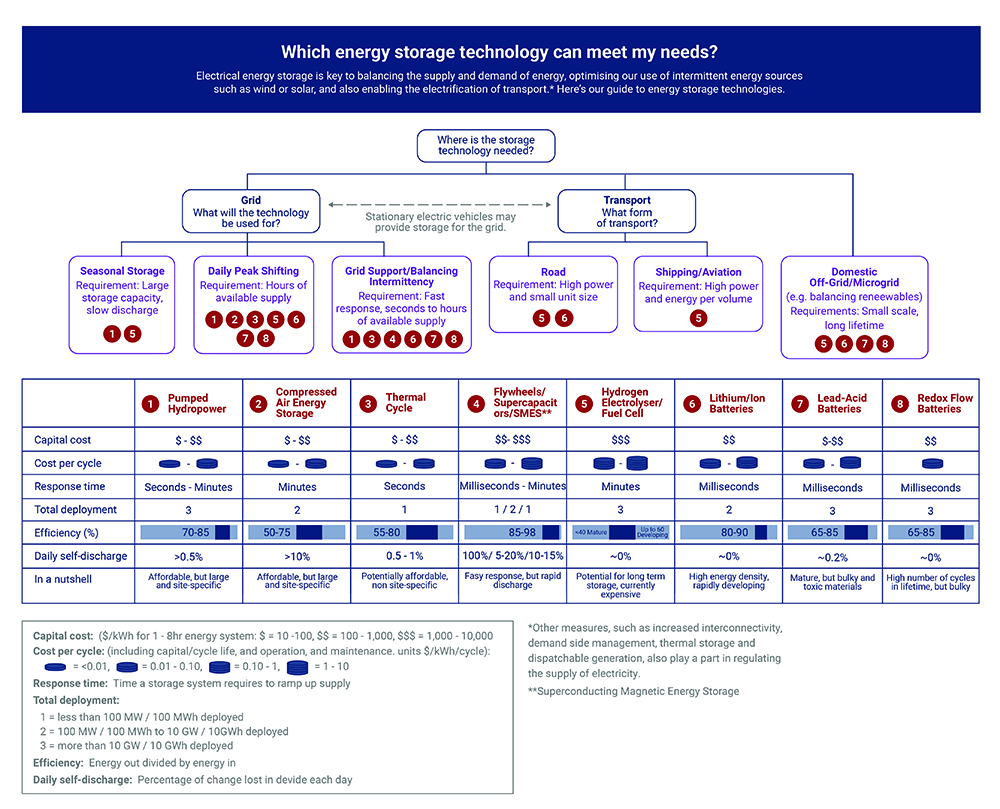
Source: Grantham Institute
Lithium-ion Batteries range in chemical composition, but all lithium-ion batteries transfer lithium-ions between their cathode and anode, where the cathode is usually a metal oxide. The variety of chemical compositions allows for a variety of capabilities and applications. Depending on the chemistry differences, each type has varying benefits and concerns, and overall, some combinations are more useful than others. Ultimately, the benefits of lithium-ion include high energy density, relatively less expensive than other battery chemistries, long lifetime cycles, the ability to recharge, low maintenance, and high rate discharge capability. In 2023, lithium-ion batteries were successfully deployed on the grid and in electric vehicles, mobile phones, and laptops.
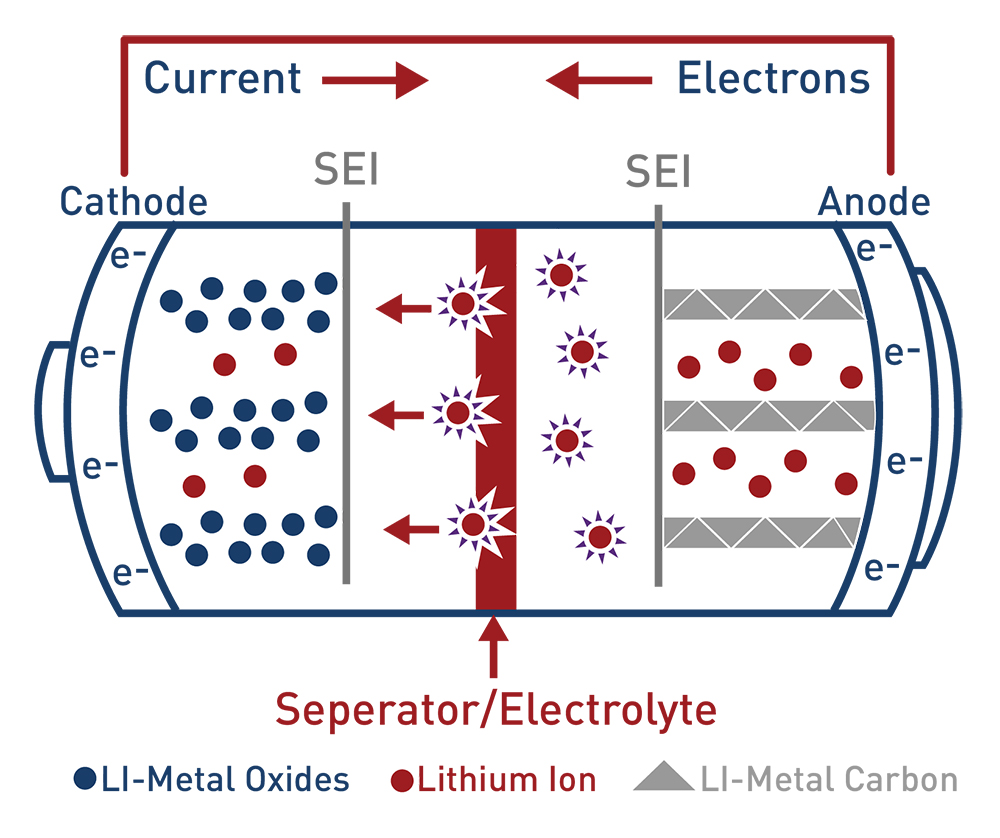
Solid State Batteries have solid electrodes, cathodes, and anodes regardless of their chemistry. Basic chemistry varies in the types of solid-state batteries, with two being very common: nickel-cadmium and sodium-sulfur. Nickel-cadmium batteries are considered a traditional battery, meaning they remain a valid option to provide a long and reliable life cycle even though energy density and cost are not as optimal as lithium-ion. Nickel-cadmium batteries have been used successfully in grid-scale storage as well for short-duration use, and in island grid systems. Sodium-sulfur batteries are another stationary application with high efficiency. While both of these battery chemistries have been tested and deployed, they are still not nearly as common as lithium-ion batteries, which currently dominate the market.
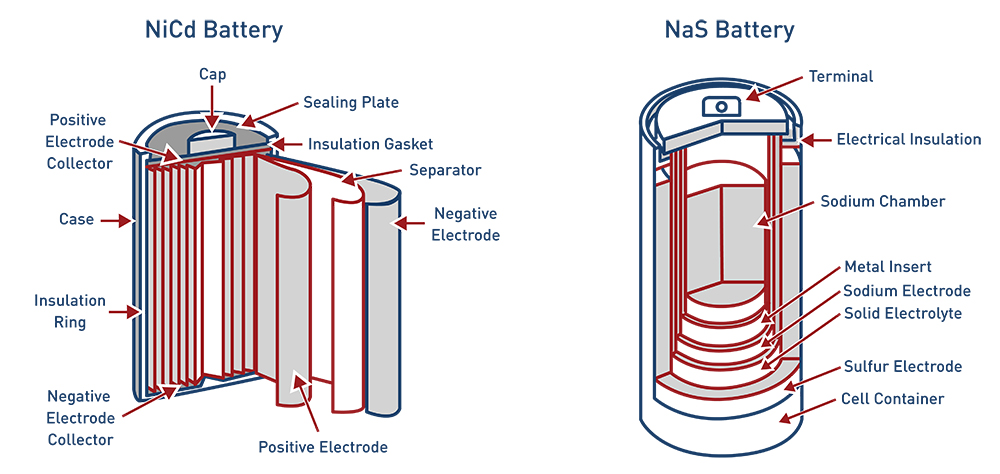
Flow Batteries consist of a reversible chemical reaction that occurs in multiple tanks. The electrodes are dissolved in electrolyte solutions in these tanks; the anolyte tank contains an anode, and the catholyte tank contains a cathode. These solutions are pumped into cell stacks where the reversible reactions occur when the battery charges and discharges. Flow batteries vary depending on the materials used for the chemical reaction in the electrolyte tanks.
Generally, flow batteries have high energy efficiency, long life cycles, can be long-duration with fast response times, and are capable of deep discharges. However, electrolyte stability and material corrosion are concerns.

Flywheels are a very short-duration form of energy storage that stores and uses the energy of a rotating mass. This rotating mass, the flywheel, is connected to a reversible electrical machine. When charging, the flywheel acts as a motor that draws electricity from the grid to spin the flywheel up to a selected operating speed. The amount of energy that can be stored in a flywheel depends primarily on the momentum of inertia of the rotor (i.e., the weight) and the speed at which it rotates. While flywheels have fast discharging capabilities, long life cycles, and no capacity degradation over time, they have low energy density and can self-discharge. Overall, flywheels are best for frequency stabilization in the power grid rather than medium or long-duration energy storage.
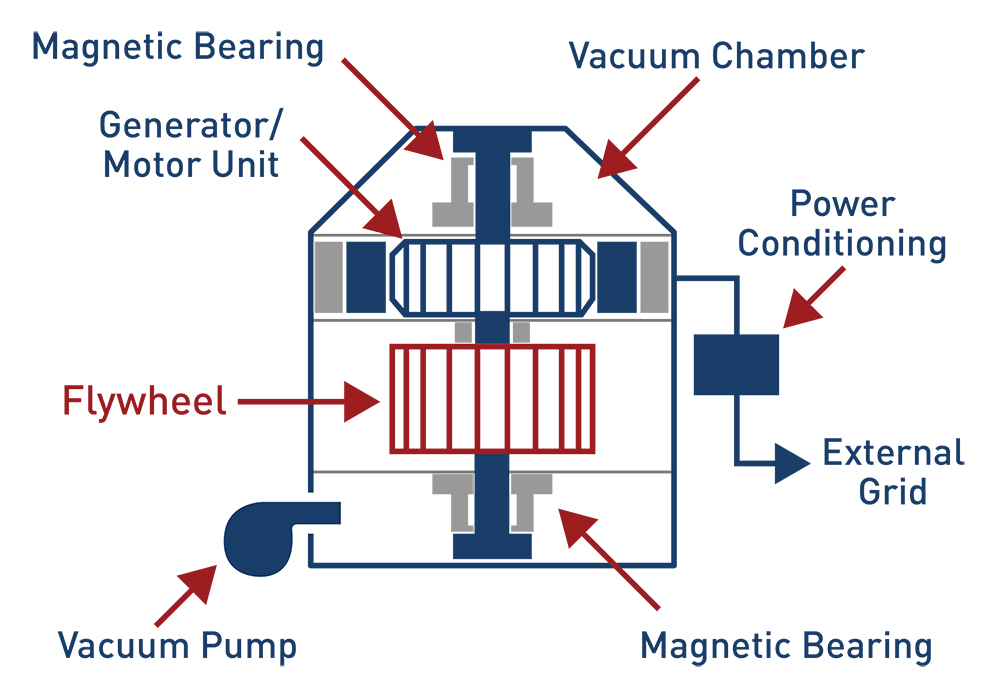
Thermal Energy Storage takes excess energy and stores it in various materials, including rocks, cement, storage tanks, carbon blocks, hydrogen, and liquid air. This type of storage is a transfer of energy into a material capable of storing the energy for a longer time frame instead of wasting the excess or less expensive energy. One example is solar thermal water heating. Advances in this technology subset offer the potential for industrial customers who need on-site storage solutions.

Hydrogen Energy Storage stores electrical energy in hydrogen through electrolysis. This means electricity is used for hydrogen production through electrolysis, where water molecules are split into oxygen and hydrogen ions. The oxygen is released, and the hydrogen is stored in pressurized containers and can be used as fuel to be burned in combined cycle gas-fired power plants or re-electrified later through fuel cells.
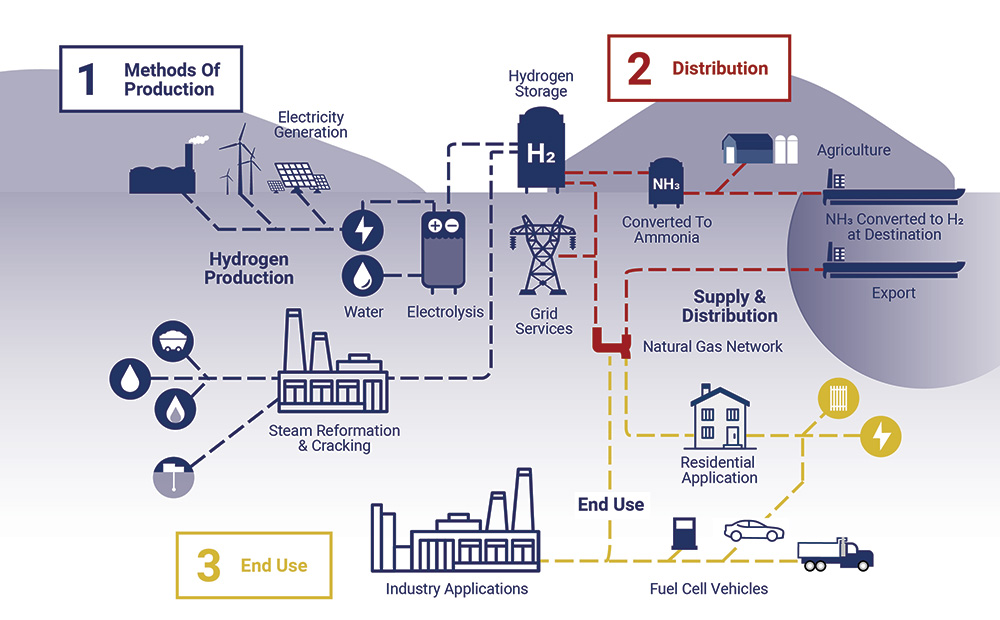
Source: Ceros
Liquid Air Energy Storage stores energy through compressed and liquefied air. First, electrical energy is used to pull air from the environment, which is then cooled until the air liquefies. The liquified air is stored in a low-pressure insulated tank until it is eventually needed. When the energy is needed, the liquid air is pumped from the tank to a higher pressure, where it evaporates and is heated. This produces a high-pressure gas used to turn a turbine and create electricity.
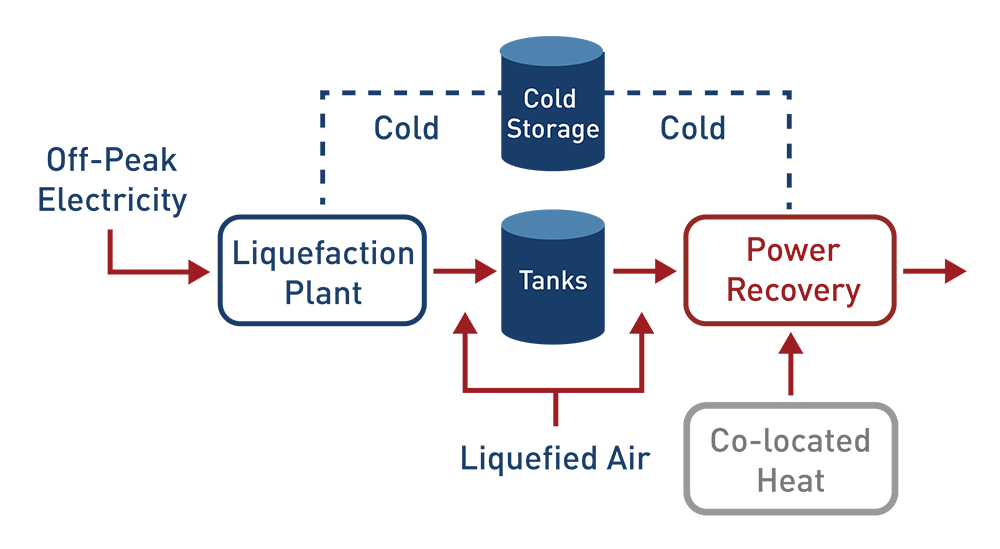
Pumped Hydropower uses gravity to turn a turbine. While this technology has been successful since the 1920s, it has been modified for additional uses such as underground pumped hydro, reservoir pumped hydro, and variable speed pumped hydro. In many cases, pumped hydropower is used for baseload electricity generation because it is reliable and inexpensive. However, over time, it has become much more complex and is used in various ways to help improve grid stability. For example, pumped hydro can operate like a “peaker plant” and operate when energy demand is at its highest to help reduce natural gas consumption in natural gas peaker plants through variable speed pump turbines.
Traditional pumped hydropower stores energy in an upper or higher elevation reservoir than a lower reservoir. When wanting to store energy, water is pumped to the higher reservoir for later use. To “discharge,” or use the stored energy, it is released to the lower reservoir to generate electricity by turning a turbine.
Underground pumped hydropower also uses two reservoirs, which can be in man-made storage reservoirs, mines, or caverns. In this system, similar to the above-ground systems, water is pumped from the lower reservoir to the higher reservoir as it “charges” the system, and to generate electricity, the water is released from the higher reservoir to the lower reservoir while spinning a turbine.

Compressed Air Energy Storage or CAES stores energy in the form of compressed air in an underground reservoir for use at a later time. CAES is very similar to pumped hydropower storage concepts. Using the stored air, however, is different than simply releasing water through a turbine. CAES systems release the pressurized air by heating it to expand it, which then turns a turbine, generating electricity. CAES has several benefits, but it works best for balancing energy, allowing greater integration of renewable energy, and providing ancillary services for the grid, such as regulation, the ability to black-start, and grid stabilization.
Compressed carbon dioxide can similarly be used for energy storage. Energy Dome is a company that has designed a battery that works almost identically to CAES but uses carbon dioxide to generate power with a turbine. With this technology, carbon dioxide is pumped into a large gasholder, or dome, and goes through a repetitive thermodynamic cycle to produce electricity. During low demand, the carbon dioxide flows from the dome, is compressed, and then stored in liquid form for later use. When demand rises, the pressurized carbon dioxide is heated until it evaporates and expands, turning a turbine to generate electricity, and the carbon dioxide is then returned to the dome for the process to repeat. Similar to CAES, compressed carbon dioxide storage can help balance and stabilize the grid, allowing for greater renewable energy penetration.

Broad Investment in Research and Development Accelerating research, development, and demonstration of grid-scale storage solutions needs to occur to continue to advance technologies. Improved coordination of existing energy storage research and development under unified outcomes and goals is essential to this cause. In recent years, the DOE energy storage research programs have increased in importance as the U.S. electricity system has evolved and demanded technologies to meet grid operational needs. That importance has led to increased federal investments, but a disjointed research effort that has yielded technological development could be better focused to facilitate the step-change breakthrough needed. Finally, research and development efforts should cover a broad suite of energy storage technologies, not just a small subset.
Diversification of Supply Chains Lithium-ion batteries have dominated the storage market for nearly three decades and have continued to drop in costs rapidly. This has produced dividends for electronics, electric cars, and grid ancillary services. However, lithium-ion technologies also have their limitations. The primary concern for policymakers in the future of lithium-ion batteries is the constraints on supply chains of various metals and minerals used in their production, like lithium, graphite, nickel, and cobalt. There is currently not enough production of these materials to meet projected demand.
For instance, most current lithium-ion battery chemistries contain cobalt, which only exists in a few regions worldwide, including the Democratic Republic of Congo (DRC), Russia, Australia, Canada, and Zambia. The DRC is home to 70% of the world’s cobalt, and China now owns all of the major cobalt mines in the country. While a critical minerals supply chain cornered by one of America’s geopolitical foes is worrying, there is the added concern of human rights abuses in the cobalt industry.
This need for limited critical mineral supplies has opened the door for alternative battery technologies that utilize different mineral sets to find space in a growing market. A report by the Atlantic Council found that, “Broadening the range of mineral inputs for chemical battery storage will open new opportunities to support the development of clean energy supply chains which meet the criteria increasingly mandated by clean energy stakeholders: environmental sustainability, good governance, and market transparency.” Such efforts will be crucial as global demand for storage rises.
Targeted Support for Long Duration Energy Storage (LDES) A report from the Department of Energy assessed that the U.S. grid may need 225-460 GW capacity of Long Duration Energy Storage (LDES) to get to net-zero by 2060. This represents $330 billion in cumulative capital. While this will require significant levels of investment, analysis shows that by 2050, net-zero pathways that deploy LDES will result in $10-20 billion in annualized savings in operating costs and avoided capital expenditures compared to pathways that do not.
Development of Market Structures Conducive to Storage Expansion Beyond policies centered around research and development of new and more efficient technologies, stakeholders in the operation, management, and regulation of the grid need to address policy issues surrounding market design. Despite FERC taking action with Order 841 in 2018, the current market structures were not designed with storage - especially LDES - in mind. More and more, it is becoming apparent that as storage resources become more critical, there needs to be better mechanisms for acknowledging and quantifying their benefits to the grid and compensating them for the benefits they bring.
